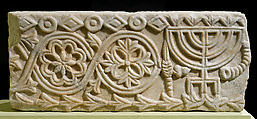Returned to lender The Met accepts temporary loans of art both for short-term exhibitions and for long-term display in its galleries.
Fragment of a Synagogue Screen with Menorah
Not on view
The Synagogue at Ashkelon
During the Byzantine period, the synagogue was constructed to promote an atmosphere of sanctity and was often referred to as "the holy place." It featured wall inscriptions and intricately carved reliefs as well as a chancel screen. An innovation adopted from Christian contexts and seen in many synagogues from this period, the screen separated the Holy Ark housing the Torah scrolls, the most sacred part of the synagogue, from the rest of the hall. Fragments of the Ashkelon Synagogue were discovered during the nineteenth century, though no complete structure has ever been excavated.
Each side of this intricately carved relief from the synagogue’s chancel screen features a menorah alongside guilloches containing rosettes. The menorah is flanked by a shofar (ram’s horn), a lulav (palm frond), and an ethrog (citron), which often appear in the decoration of Byzantine synagogues.
Due to rights restrictions, this image cannot be enlarged, viewed at full screen, or downloaded.
This artwork is meant to be viewed from right to left. Scroll left to view more.



